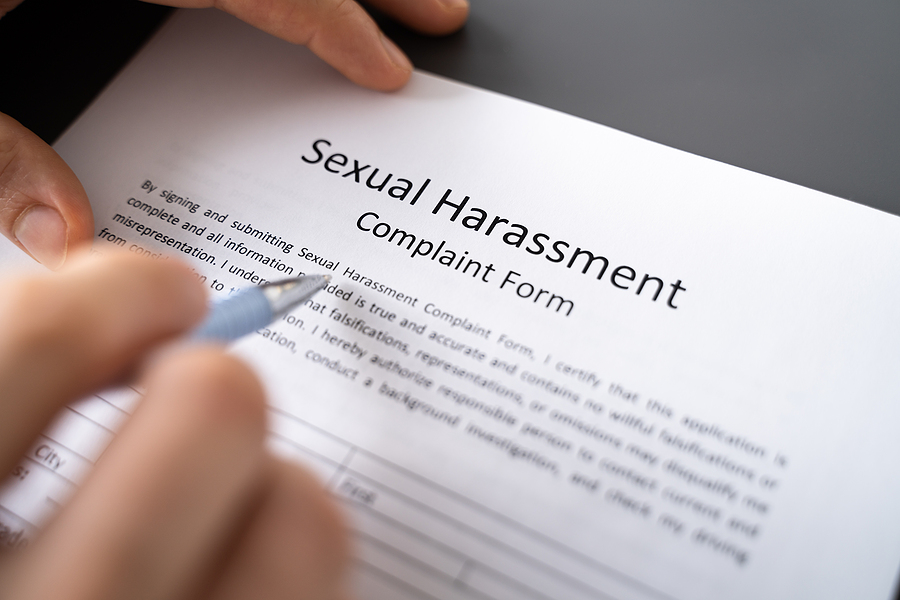
The New Title IX Rule on Addressing Sex Discrimination in K–12 and Postsecondary Schools — Part 2: Title IX Complaint Process
Part 1 of this series provided a general overview of the Title IX Amendments of 2020 (the new Title IX rule or the Final Rule), how they differ from previous amendments, a definition of sexual harassment, the role of the Title IX coordinator, and who should report allegations of sexual harassment to the school. In Part 2, we will review the Title IX complaint process once a report of sexual harassment occurs, how a Title IX complaint is filed, how a Title IX investigation is implemented, and how a school must respond to allegations of sexual harassment.
Examples of where the Title IX complaint process could apply
Schools are unclear at times about what constitutes notice of sexual harassment that would require the school to initiate the Title IX complaint process. In many school districts, there is not even a designated Title IX coordinator, even though it is required under Title IX regulations. The latest data on sexual misconduct, however, underscore the importance of having a clear process in place. In the United States Youth Risk Behavior Surveillance, 2017, conducted by the Centers for Disease Control and Prevention, 15.2% of all high school students said they had experienced sexual violence by anyone.[cm_simple_footnote id=”1″] Moreover, according to a school climate survey administered in 2019 to college and university students by the Association of American Universities, the overall rate of nonconsensual sexual contact by physical force or inability to consent since the student enrolled at the school was 13%.
Here are some possible scenarios of sexual violence in schools and universities in which the Title IX Final Rule could apply. Parentheses denote the type of sexual harassment specifically defined in the Final Rule.
- An eighth-grade female student is continually harassed by a male classmate to have sex with her. As a result, she is afraid to come to school, her grades suffer, and she begins to have emotional issues. The student complains of the continual harassment to her guidance counselor and to her best friend, but no action is taken. After repeatedly being denied by the female student, the male student follows the student down an unsupervised stairwell in the school and rapes her (sexual assault, as defined by the Clery Act or the Violence Against Women Act).
- A high school science teacher has a three-month sexual relationship with one of his 15-year-old female students. Over this period, school officials receive anonymous text messages, e-mails, and parent complaints that this relationship was going on, even as the student and the teacher deny a relationship. The school does not conduct a Title IX investigation and no measures are put in place to protect the student. During the relationship, the student increasingly shows signs of a student at risk: cutting marks on her wrists; failing grades (except for this teacher’s class); lack of interest in friends and school. The relationship ends when the student’s mother and father use their daughter’s phone to track her location, then finds her having sex with the teacher in his car (severe, pervasive, and objectively offensive that it has denied the complainant equal access to the school’s education program or activity).
- A female university professor promises a male student an “A” in her philosophy class in exchange for sexual favors. The professor began grooming[cm_simple_footnote id=”2″] the student at the beginning of the semester and eventually invited the student to dinners at her campus apartment. Feeling boxed in, the student does not know whom on campus to trust, does not know who the university’s Title IX coordinator is, and does not know whom on campus should receive a complaint about sexual abuse (quid pro quo).
- A female high school gymnast is stalked and harassed by the school’s male athletic trainer and complains about it to her coach, who dismisses her complaints and never notifies the school’s Title IX coordinator. Only after other female athletes file similar complaints against the trainer does the school investigate the matter (stalking as defined under the Clery Act or Violence Against Women Act).
- A male teacher is grooming middle school male students by hiring them to work at his home, allowing them to drive his car, and providing alcohol and marijuana for them on weekends. Subsequently, over a period of several years, he rapes several students in his windowless office after school and on field trips that he chaperones. Embarrassed, students are too afraid to tell anyone at the time. Several years later, complaints are filed against the teacher (severe, pervasive, and objectively offensive that it effectively denied the complainants equal access to the school’s education program or activity).
- Over a span of several days, an elementary school gym teacher sexually assaults female kindergarten students in the gym while the student is sitting on the teacher’s lap during movie time. The lights are off in the gym so no one can see the teacher assault the student and all of the other students are facing away from the teacher, watching the movie (severe, pervasive, and objectively offensive that it effectively denied the complainants equal access to the school’s education program or activity).
Under the Final Rule, each of these scenarios would fall under the definition of sexual harassment, requiring the school to respond and initiate the Title IX complaint process. A school must respond when: (1) the school has actual knowledge of sexual harassment; (2) the incident occurred within the school’s education program or activity; and (3) the incident occurs in the United States.
The 2020 Final Rule expands the scope of receipt of actual knowledge, stipulating that any elementary or secondary school employee can receive actual knowledge and that any person (e.g., the alleged victim or any third party) may report to a Title IX coordinator in person or by e-mail, phone, or mail. This is why training all K–12 employees to recognize signs of sexual harassment and notify the Title IX coordinator when they see it is critical. In K–12 schools, custodians, food service employees, and teacher aides may be most likely to observe abusive situations because of their contact with large groups of children in unstructured settings (hallways, stairwells, playgrounds, and cafeterias). Postsecondary schools may empower as many officials as they wish, including professors, coaches, and athletic trainers, to respond to allegations.
Regardless of the level, a school is required to respond promptly and appropriately if it has notice of an alleged misconduct of sexual harassment, even if the complainant is not certain whether harassment has occurred. When a school is in doubt about whether an incident falls under Title IX, it should always err on the side of caution and begin the Title IX complaint process.
Title IX Process Overview Flowchart. Source: Nuttall, MacAvoy, & Joyce, P.C. (Joyce, 2021).
Initiating the Title IX complaint process with supportive measures in the school after a sexual harassment allegation
Once a school has received notice of an alleged sexual harassment incident, it must offer supportive measures to every complainant, regardless if a formal complaint is filed. Supportive measures “are designed to restore or preserve equal access to the [school’s] education program or activity” (Office for Civil Rights [OCR], 2022, p. 18). Moreover, these include “measures designed to protect the safety of all parties or the school’s educational environment, or deter sexual harassment” (OCR, 2022, p. 18). A school also must consider the complainant’s wishes in determining which supportive measures to provide and may not provide supportive measures that “unreasonably burden the other party” (OCR, 2022, p. 18). It is important to note that supportive measures are confidential unless a party needs to know, such as a no-contact or stay-away order.
During the Title IX complaint process, the school has discretion and flexibility to determine which supportive measures are appropriate. Examples include “counseling, extensions of deadlines or other course-related adjustments, modifications of work or class schedules, campus escort services, mutual restrictions on contact between the parties, changes in work or housing locations, leaves of absence, increased security and monitoring of certain areas of the campus, and other similar measures” (OCR, 2022, p. 18). Furthermore, a school may remove the subject of the complaint (the respondent) from its education program or activity on an emergency basis if an individualized safety and risk analysis determines that not doing so would pose an immediate threat to the physical health or safety of any student. If the school is going to remove the respondent, it must notify the respondent and provide an opportunity to challenge the decision immediately following the removal. This includes placing employee respondents on administrative leave while a Title IX grievance is pending. In both instances, the school must comply with any federal disability laws that may be applicable.
Filing a formal complaint in the Title IX complaint process
The Title IX coordinator must also inform the complainant that he or she has the right to file a formal complaint. A formal complaint is a document filed either hard copy or electronically by a complainant alleging sexual harassment against a respondent and requesting that the school investigate the allegation (OCR, 2022, p. 14). A parent or guardian may also file a formal complaint on that individual’s behalf. If a complainant is not currently enrolled in or attending the school, he or she may still file a formal complaint if attempting to participate in a school’s education program. If a complainant has not filed a formal complaint, a Title IX coordinator may initiate a formal complaint. A school is required to take action even if the respondent leaves the school before a formal complaint is filed and has no plans to return. Finally, a school has discretion to assess the facts and circumstances of a case before deciding whether to dismiss the complaint if the respondent has left the school.
What schools must do after a formal complaint is filed and the Title IX complaint process is initiated
During the Title lX complaint process, schools must investigate every formal complaint. If the alleged conduct does not fall under Title IX, then a school may address the allegations under the school’s own code of conduct, state laws, policies, and procedures and provide supportive measures. Any time after a formal complaint has been filed, the parties may opt to go through an informal resolution process. Informal resolution allows both parties, with their voluntary written consent, to proceed with processes such as mediation or restorative justice to settle the issues. The informal resolution process cannot be used when an employee allegedly sexually harasses a student. That type of allegation must always go through the Title IX complaint process once the complaint has been filed.
If an informal resolution cannot be reached or if an employee allegedly sexually harasses a student, then the Title IX complaint process begins. The Final Rule requires schools to investigate and adjudicate formal complaints of sexual harassment using a grievance process that incorporates due-process principles, treats all parties fairly, and reaches reliable responsibility determinations. Once a written formal complaint has been filed, the Title IX coordinator conducts an initial assessment of the complaint. If the complaint meets the criteria, the Title IX coordinator sends written correspondence to both the complainant and the respondent, notifying them of the allegations. It is important to note that the Title IX coordinator may also hold the role of the investigator or informal resolution facilitator, but not both. Furthermore, the Title IX coordinator can never be the decision maker or appeals officer.
The Title IX investigator(s) must be trained to gather evidence and complete an impartial investigation. According to the new Title IX regulations, the investigator needs to apply a presumption that the respondent is not responsible for the allegation during the Title IX complaint process so that the school bears the burden of proof and the standard of evidence is applied correctly. The investigator interviews the complainant, the respondent, and any witnesses; identifies, organizes, and compiles relevant information and evidence; and then sends all evidence directly related to the allegations, including all inculpatory[cm_simple_footnote id=”3″] and exculpatory[cm_simple_footnote id=”4″] evidence, to each party and provides 10 days for the parties to provide a written response. Once the 10-day window has passed, the Title IX investigator drafts an investigative report that summarizes the relevant evidence. This report is sent to the decision maker and to both parties for review.
The role of the decision maker in the Title IX complaint process
Once the decision maker receives the draft investigative report, several procedural steps must be taken to ensure a fair opportunity for both parties to give input on the report. Elementary and secondary schools must give each party an opportunity to submit written questions to ask of any party or witness. Parties have 10 days from receipt of the draft investigative report to submit questions. If the decision maker excludes any questions as irrelevant, this must be explained to the party proposing the questions (OCR, 2022, p. 21). The decision maker must provide each party with the answers and allow for additional, limited follow-up questions. At the postsecondary level, schools must have a live hearing where each party’s advisor must be permitted to ask the other party and any witnesses all relevant questions and follow-up questions, including those challenging credibility.
When the decision maker is providing a determination of responsibility, one of two standards of proof must be used: preponderance of the evidence or clear and convincing evidence. The preamble in the 2020 Title IX amendments explains that the preponderance-of-the-evidence standard means the decision maker must determine whether alleged facts are more likely than not to be true. It also explains that the clear-and-convincing-evidence standard means the decision maker must determine whether it is “highly probable” that the alleged facts are true (OCR, 2022, p. 30). The clear-and-convincing-evidence standard is a higher burden of persuasion than preponderance of the evidence, but less than the standard of beyond a reasonable doubt. Whichever standard is used in the Title IX complaint process, it must be determined in advance and applied consistently to formal complaints against students and employees. A determination of responsibility must be stated clearly in writing, explaining whether the facts meet the definition of sexual harassment under Title IX and how and why the decision maker reached conclusions. There are three possible outcomes:
- There is sufficient evidence to find the respondent responsible for the allegations of sexual harassment
- There is insufficient evidence to find the respondent responsible for the allegations of sexual harassment
- There is mixed determination of responsibility, meaning that there is sufficient evidence to support some but not all of the allegations
Once a determination of responsibility has been made, the decision maker needs to provide notification of possible disciplinary action in line with the school district or university code of conduct, collective bargaining agreement, or employee handbook. In addition, the complainant must be notified of any remedies designed to restore or preserve equal access to the recipient’s education program or activity. These remedies are confidential. Finally, both parties are provided with notice of the right to appeal and contact information for the appeals officer. The Final Rule forbids the appeals officer from being the decision maker, the Title IX coordinator, or the investigator. In many school districts, the appeals officer is the superintendent. In colleges and universities, it is usually a dean of students.
The Title IX appeals process
If either the dismissal of the complaint or the determination of responsibility is appealed, the appeals officer must send a notice of appeal to the other party. The appeals officer determines, on the basis of specific criteria, whether the appeal can move forward. Those criteria are:
- A procedural irregularity that affected the outcome of the matter
- Newly discovered evidence that could affect the outcome, and/or
- One of the Title IX personnel had a conflict of interest or bias that affected the outcome
The formal Title IX complaint process is complete either when the time period for appeal has lapsed[cm_simple_footnote id=”5″] or upon issuance of the appeal officer’s decision on a timely filed appeal.
No disciplinary action, if applicable, can be imposed on the respondent until the Title IX appeal process has taken place and has been completed. Once the process is complete, the respondent may receive notice of his or her rights based on the potential discipline under separate cover. If the respondent is a special education student, a manifestation determination [cm_simple_footnote id=”6″] must be held if the student is to be removed for more than 10 days and the school district knows or has reason to know that the student has a disability.
Conclusion
The Title IX complaint process that a school or university must follow after receipt of sexual harassment is very procedure-driven, with clear roles and responsibilities for each member of the investigatory process. Appointing a trained Title IX coordinator and providing training to all employees is critical to the success of the process. Failure to effectively coordinate a comprehensive Title IX investigation could lead to an Office for Civil Rights Investigation or a potential liability issue against the school. The third and final article in this series, later this year, will review what schools and universities can do to prepare for a Title IX grievance process with scenarios of Title IX cases.
References
Joyce, M.J. (2021, November 10). New Title IX regulations: In depth training for Title IX coordinators, administrators, and Title IX team [Paper presentation]. Massachusetts Partnerships for Youth, Marshfield, MA, United States.
Office for Civil Rights. (2022, June 28). Questions and answers on the Title IX regulations on sexual harassment. U.S. Department of Education. https://www2.ed.gov/about/offices/list/ocr/docs/202107-qa-titleix.pdf
Rape, Abuse & Incest National Network. (2020, July 10). Sexual assault – Grooming: Know the warning signs. https://www.rainn.org/news/grooming-know-warning-signs



